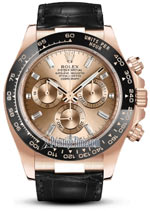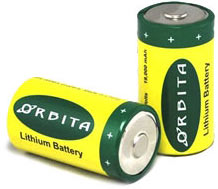What do I need to know about my automatic watch before buying a winder?
First familiarize yourself with your watch movement specifications:
- Rotor Winding Direction: Find out in which direction the rotor will wind the mainspring:
- Clockwise
- Counter-clockwise
- Bi-directional
- Turns Per Day: How many times a day must the rotor turn in order to keep the watch fully wound?
Scenarios regarding winding direction & turns per day:
The Rolex Submariner
 houses Rolex's 3135 caliber. The 3135 features a bi-directional winding rotor which requires a minimum of 650 turns per day (27 turns per hour). Most watch winders turn the required 650 times a day. In addition, since the rotor on the 3135 winds the movement bi-directionally, it doesn't really matter if the winding direction of your winder is programmable or not. As such, most watch winders will work fine for this movement.
houses Rolex's 3135 caliber. The 3135 features a bi-directional winding rotor which requires a minimum of 650 turns per day (27 turns per hour). Most watch winders turn the required 650 times a day. In addition, since the rotor on the 3135 winds the movement bi-directionally, it doesn't really matter if the winding direction of your winder is programmable or not. As such, most watch winders will work fine for this movement.

The Rolex Daytona 116520 houses Rolex’s 4130 caliber. The rotor on the 4130 movement will wind the watch when turned in any direction AND requires a minimum of 650-800 turns per day (37 turns per hour). In order to keep this watch fully wound you will require a winder that turns in either direction at least 650-800 per day. A non-programmable winder that turns in both directions would need to make a minimum 1800 turns per day in order to keep the watch fully wound, as half those turns will do nothing to wind your watch.
What do I need to know about the winder?
- Is the turning direction programmable?
- Can the winder be set to a certain amount of winds per day?
- Is your watch a chunk of metal? Perhaps a 46mm Panerai, or a 49mm IWC Big Pilot. Is there a weight restriction for top-heavy watches? If the winder you are considering is a single-head lightweight winder, will your watch tip the winder?
- If you have a large watch, how well will it fit into the winder?
- What is the power source of the winder? Plug in (AC) or battery powered (DC)?
A programmable winder will allow the user to program one or both of the necessary features: the direction the winder turns (bi-directional, clockwise or counter-clockwise) and/or select the amount of turns per day. If you are considering buying a winder with multiple heads, make sure they are individually programmable or at least groups of heads are programmable.
How to choose a winder:
As we have previously mentioned, a winder is an accessory to your watch, once you have made the decision to invest in a winder, you should look into the specs you will need. Next you should ask yourself if the purpose purely utilitarian, or do you want to dress it up a little? There as simple winders available that are stripped down of any glamorous finishes. These winders are quite affordable & will get the job done. If you want to get a fancy winder, some really nice winders are available made from a variety of materials & finishes. However, the more lavish the winder the more expensive it gets.
Lastly, think ahead. If you are considering expanding your watch collection in the near future, perhaps you should consider buying a multiple head winder that will accommodate your future purchases.
AC or DC power source:

An AC powered watch winder requires a power cord that plugs into the wall, somewhat limiting the placement of the winder. Yet, if you are considering a winder with multiple heads, it might be more practical to get an AC powered watch winder.
A DC powered winder is powered by a battery. If you want the winder to be mobile, or if you will be storing the winder in a safe, then a battery operated winder will most probably be the most practical. Orbita Corporation (of whom we are authorized dealers) offers a great line of watch winders powered by a 5 year lithium batteries.
A few last notes about winders:
Can an automatic watch be overwound?
No, an automatic watch cannot be overwound. Once the mainspring is fully wound the winding gears (rotor & crown) decouples/disengages from the movement. Watches are built to withstand constant motion; however, since there is no benefit to keep winding a watch that is already wound, it would be wise to buy a winder that can be programmed to the needs of your watch. For example, we would advise against putting a watch that requires only 650 turns per day on a winder set for 1800 turns per day, as this would result in extra wear & tear on the winding gears for no reason. However, if your watch requires only 650 winds per day & you put it on a winder that is set for 800 winds per day that would really be fine as the few extra winds will not hurt your watch.
Will keeping the watch constantly running put extra stress on the movement?
Let’s start by saying that mechanical watches are designed to be worn constantly, so the same question can be asked if you wear the watch every day. The short answer is, YES but only very minimal extra stress, nothing that one should be concerned about. After all, that is what the watch has been designed to do! On the other hand, if you own a watch with complications that will need to be reset every time the watch stops, such as a perpetual calendar, the benefits of keeping your watch constantly running far outweigh the perceived worry of adding extra stress to the movement.
Accuracy on a winder, what can I expect?
One of the biggest focuses in the watch industry has been placed on watch accuracy (see our article on this topic). In short, gravity creates drag on the escapement wheel, which is the main component regulating the time-keeping of your watch. This drag will cause the watch to speed up or slow down while in different positions. In order to correct this loss & gain, very small regulating weights are mounted to the balance wheel, which allows for a controlled speeding up or slowing down of the movement when in different positions, ultimately balancing out the losses & gains over the course of the day. Most watches are tested & regulated based on being in 5 or more positions per day. When a watch is on a winder it will typically rest in a single position most of the day, which means that the accuracy might suffer a little. One should not expect the same accuracy from a watch sitting on a winder as from a watch that is worn on the wrist.



